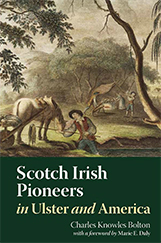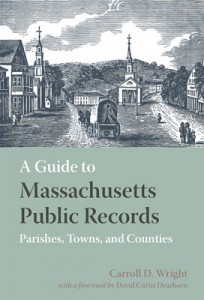 For the past several years NEHGS has been giving seminars on writing and publishing a family history. These have been very popular, and as a result, Penny Stratton and I refocused the two previous NEHGS writing guides to reflect the contents of the seminars. The resulting book is the Guide to Genealogical Writing: How to Write and Publish Your Family History (Boston: NEHGS, 2014), just released. In twelve chapters this Guide covers everything from preparing a short informal booklet up to publishing an elaborate compiled genealogy. Chapters on writing for the Register and for American Ancestors were adapted from the two previous guides. To help readers visualize some of our specific examples, we included plenty of illustrations, most of them from recently published Newbury Street Press books. Continue reading Further thoughts on genealogical writing
For the past several years NEHGS has been giving seminars on writing and publishing a family history. These have been very popular, and as a result, Penny Stratton and I refocused the two previous NEHGS writing guides to reflect the contents of the seminars. The resulting book is the Guide to Genealogical Writing: How to Write and Publish Your Family History (Boston: NEHGS, 2014), just released. In twelve chapters this Guide covers everything from preparing a short informal booklet up to publishing an elaborate compiled genealogy. Chapters on writing for the Register and for American Ancestors were adapted from the two previous guides. To help readers visualize some of our specific examples, we included plenty of illustrations, most of them from recently published Newbury Street Press books. Continue reading Further thoughts on genealogical writing
Tag Archives: The Well-Stocked Genealogical Library
Cheat Sheets: Part Four
 The first fourteen steps in my process for creating entries for the Early New England Families Study Project are covered in three previous posts, beginning here:
The first fourteen steps in my process for creating entries for the Early New England Families Study Project are covered in three previous posts, beginning here:
15. Analysis. Many, many books have been written about genealogical analysis. I have just read the most recent, Bob Anderson’s Elements of Genealogical Analysis, and highly recommend it with one caveat – it is written by a left-brained genealogist. Speaking as a right-brained genealogist, I know some readers may find themselves grumbling about “overkill,” but remember that Bob is examining the process of genealogical analysis on the cellular level. Continue reading Cheat Sheets: Part Four
International posts at Vita Brevis
 Following on from Jean Maguire’s post yesterday on NEHGS collection research options covered this year at Vita Brevis, I thought it might be useful to look at the coverage of international research at the blog. A lively group of articles follow, suggesting the range of our bloggers’ interests and research skills, beginning with Lael Dalal’s post on the Aghassi family’s hegira from Iraq to Mexico to Massachusetts:
Following on from Jean Maguire’s post yesterday on NEHGS collection research options covered this year at Vita Brevis, I thought it might be useful to look at the coverage of international research at the blog. A lively group of articles follow, suggesting the range of our bloggers’ interests and research skills, beginning with Lael Dalal’s post on the Aghassi family’s hegira from Iraq to Mexico to Massachusetts:
Isak Aghassi was born in 1889 in Baghdad and worked with his father importing dyes and teas from India, eventually focusing on carpets and tobacco. In 1946, Isak put himself, his wife Marcelle, and his two sons Badri and Jacob on a waiting list as prospective immigrants to the United States. He wrote the American Embassy in Baghdad at least once a year (receiving a yearly reply) inquiring when he and his family would be able to leave their dangerous country. The reply was always the same: the quota was over-subscribed and they would need to wait patiently. Continue reading International posts at Vita Brevis
Guides for using the NEHGS collection
 Back in February, Vita Brevis began posting a series of guides to using the NEHGS collection here in Boston and remotely at home. For ease of reference, I have collected them here, with short excerpts from the articles themselves.
Back in February, Vita Brevis began posting a series of guides to using the NEHGS collection here in Boston and remotely at home. For ease of reference, I have collected them here, with short excerpts from the articles themselves.
Anne Meringolo began the series: Have you wished that you could use NEHGS library resources from home? Have you wondered where to find copies of genealogies online? You can do this by starting with the NEHGS library catalog.Staff and dedicated volunteers have been working to add links to freely available e-books as well as to genealogies and items from our manuscript and book collections for members to use. Continue reading Guides for using the NEHGS collection
Cheat Sheets: Part Three
 The first nine steps in my process for creating entries for the Early New England Families Study Project are covered here and here.
The first nine steps in my process for creating entries for the Early New England Families Study Project are covered here and here.
10. Town Histories, Genealogical Dictionaries, Town Records (Town). I can access almost any classic published history on-line, many of which include genealogical sections, as well as standard “dictionaries” of families associated with a town, such as Bond’s Watertown and Wyman’s Charlestown Genealogies. An essential regional source not available online (but available as a reprint from NEHGS) is Genealogical Dictionary of Maine and New Hampshire. Published records of a town – other than vital records – such as Jeremy Bangs’ records for Sandwich (mentioned in an earlier post), also fall into this category. Continue reading Cheat Sheets: Part Three
Puritan Pedigrees
 Now that my book on genealogical research methods (Elements of Genealogical Analysis) is out, I have turned my attention to the series of lectures I will be delivering in October and November; these, in turn, will form the basis for a future book entitled Puritan Pedigrees: The Deep Roots of the Great Migration to New England.
Now that my book on genealogical research methods (Elements of Genealogical Analysis) is out, I have turned my attention to the series of lectures I will be delivering in October and November; these, in turn, will form the basis for a future book entitled Puritan Pedigrees: The Deep Roots of the Great Migration to New England.
In most of the Great Migration volumes, I have been able to examine the motivations of the migrating families only in the context of events at the time of migration. A few years ago, while working on The Winthrop Fleet, I began to get a better feel for the deeper connections and influences which had been developing for decades and for generations leading up to the migration decision. Continue reading Puritan Pedigrees
Who was Robert Henry Eddy, and why should you care?
 Robert Henry Eddy was a life member of NEHGS who died in 1887 and bequeathed a substantial sum of money to the Society.* Mr. Eddy had been an architect, civil engineer, and in later life, a very successful patent attorney. In 1902, NEHGS used $20,000 of the Eddy bequest to establish the “Eddy Town-Record Fund, for the sole purpose of publishing the Vital Records of the towns of Massachusetts.” This fund would become the basis of a major project to preserve early Massachusetts vital records. Continue reading Who was Robert Henry Eddy, and why should you care?
Robert Henry Eddy was a life member of NEHGS who died in 1887 and bequeathed a substantial sum of money to the Society.* Mr. Eddy had been an architect, civil engineer, and in later life, a very successful patent attorney. In 1902, NEHGS used $20,000 of the Eddy bequest to establish the “Eddy Town-Record Fund, for the sole purpose of publishing the Vital Records of the towns of Massachusetts.” This fund would become the basis of a major project to preserve early Massachusetts vital records. Continue reading Who was Robert Henry Eddy, and why should you care?
Public Records of Massachusetts Parishes, Towns and Counties
 Despite its relatively small size, Massachusetts arguably has the most complete and comprehensive set of records of historical value of any state. Record-keeping began shortly after the first settlements were established, and for the most part the records have survived to a remarkable degree. The records themselves exist at every level of government: state, county, and town.
Despite its relatively small size, Massachusetts arguably has the most complete and comprehensive set of records of historical value of any state. Record-keeping began shortly after the first settlements were established, and for the most part the records have survived to a remarkable degree. The records themselves exist at every level of government: state, county, and town.
By the mid-nineteenth century, agitation grew for establishing a public records commission, such as existed at the time in England, with the power to bring all the Commonwealth’s important records into a single repository. Other parties objected to this idea, both because of the possible expense involved, but mainly because many local officials objected to giving up custody of their records. Continue reading Public Records of Massachusetts Parishes, Towns and Counties
Cheat Sheets
 I create cheat sheets for projects, but most of them reside inside my head or on scattered pieces of paper in my office – both of which suffer from notorious clutter issues – so it seems like a good exercise to gather and record the process here. In this case, of course, the cheat sheets are for doing research on seventeenth-century New England families, but the basics can be applied to other situations. Also, no search ever progresses exactly the same as any other, so this list is meant to be flexible. Continue reading Cheat Sheets
I create cheat sheets for projects, but most of them reside inside my head or on scattered pieces of paper in my office – both of which suffer from notorious clutter issues – so it seems like a good exercise to gather and record the process here. In this case, of course, the cheat sheets are for doing research on seventeenth-century New England families, but the basics can be applied to other situations. Also, no search ever progresses exactly the same as any other, so this list is meant to be flexible. Continue reading Cheat Sheets
The ‘Do Not Read List’

Jimmy Fallon recently aired his recurring segment, the “Do Not Read List,” which pokes fun at books with unfortunate titles or unconventional subjects. To my surprise, one of the books featured on the spot was the popular genealogical resource, List of Persons Whose Names Have Been Changed in Massachusetts, 1780-1892. Fallon introduced the book with a sarcastic joke: “420 pages of names … changed names. That’s a page turner.” Then, he proceeded to mock those who changed their generic names to something comical. Continue reading The ‘Do Not Read List’